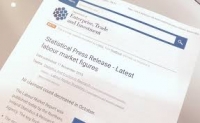
NORTHERN IRELAND - Labour market statistics.
The labour market statistics were published today by the Northern Ireland Statistics and Research Agency.
NI unemployment rate increased over the quarter and decreased over the year
- The NI seasonally adjusted unemployment rate (the proportion of economically active people aged 16+ who were unemployed) for the period November-January 2020 was estimated from the Labour Force Survey at 2.4%, one of the lowest rates on record. The unemployment rate increased over the quarter by 0.1 percentage points (pps) from the lowest rate on record and decreased by 1.1pps over the year. The annual change was statistically significant, i.e. the recorded change exceeded the variability expected from a sample survey of this size and was likely to reflect real change.
- The NI unemployment rate (2.4%) was below the UK rate (3.9%), the European Union (28) rate (6.2%) for December 2019 and the Republic of Ireland rate (4.8%) for December 2019.
Employment rate decreased over the quarter and increased over the year
- The proportion of people aged 16 to 64 in work (the employment rate) decreased over the quarter by 0.1pps and increased over the year by 1.3pps to 72.3%, one of the highest rates on record. Although recent changes were not statistically significant, the employment rate was significantly above rates in 2018.
Economic inactivity was unchanged over the quarter and decreased over the year
- The economic inactivity rate (the proportion of people aged from 16 to 64 who were not working and not seeking or available to work) was unchanged over the quarter and decreased over the year by 0.5pps to one of the lowest rates on record (25.9%). Although the annual change was not statistically significant, the economic inactivity rate was significantly below rates in 2017.
Confirmed redundancies increased over the year
- The number of confirmed redundancies (3,045) in the most recent 12 months was 29% higher than in the previous 12 months (2,359). NISRA, acting on behalf of the Department for the Economy, received confirmation that 23 redundancies took place in February 2020.
- A total of 99 redundancies were proposed in February 2020, a decrease on the previous month’s total of 424.
Total Employee Jobs increased over the quarter and year
- Estimates from the Quarterly Employment Survey December 2019 indicate that private sector jobs decreased over the quarter (-0.1% or -430 jobs) and increased over the year (1.2% or 6,810 jobs). Public sector jobs increased over both the quarter and the year. The number of public sector jobs is estimated at 211,670 and is 7% below its highest level in September 2009.
- The total number of employee jobs increased over the quarter (1,790 jobs) and over the year (10,730 jobs) to 784,140; the highest number of jobs on record (in the seasonally adjusted series).
- Construction was the only broad industry sector to experience a decrease in employee jobs over the year, although this decrease was marginal at 0.2% (-50 jobs). The services sector, which accounts for 81% of jobs in NI, accounted for the majority of the annual growth (93%). This is consistent with trends since recovery began in 2012.
Commentary
- Businesses and households continued to report relatively strong labour market conditions.
- Businesses reported via the Quarterly Employment Survey that employee jobs increased over the quarter and year to a record high of 784,140 jobs. This continues a period of quarter on quarter growth from December 2015. The service and manufacturing sectors reported growth in jobs over the year while the construction sector experienced a marginal decrease. The services sector continues to account for the majority of growth in jobs.
- Estimates from the Labour Force Survey showed a marginal decrease in the employment rate, a marginal increase in the unemployment rate, and no change in the economic inactivity rate over the quarter. The unemployment (2.4%) and economic inactivity (25.9%) rates were both lower than one year ago while the employment rate (72.3%) was higher than one year ago.
- The continued improvements in the NI labour market are in keeping with the UK experience. It is worth noting, while the NI unemployment rate continues to be the lowest of all the UK regions, NI had the second lowest employment rate and highest economic inactivity rate.
ABC Comment, have your say below:
